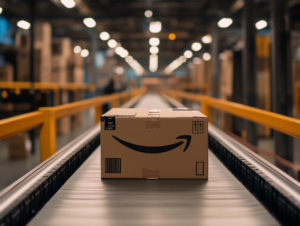Price optimization stands at the heart of Amazon’s marketplace dominance. Their dynamic pricing system executes millions of price adjustments every 10 minutes, powering vendor success with average sales increasing by 52% annually.
The stakes are clear – 2 million active sellers compete for visibility, while 80-90% of purchases flow through Amazon’s Buy Box. Success demands mastery of their pricing algorithm, which processes vast data streams spanning competitor prices, customer patterns, and inventory positions to maximize both revenue and buyer satisfaction.
This analysis of Amazon’s $31B machine learning strategy uncovers the building blocks of their pricing infrastructure. You’ll discover their data-driven decision engine, price optimization system, and real-time adjustment capabilities. The findings reveal how Amazon’s pricing technology shapes the future of e-commerce success.
Amazon’s ML Infrastructure for Dynamic Pricing
“AI-based dynamic pricing tools use machine learning algorithms to analyze multiple factors that influence pricing, such as demand trends, competitor prices, and sales history.” — 7Learnings, AI-based pricing technology company
Price decisions at Amazon flow through a powerful machine learning system built on AWS cloud architecture. Their pricing engine processes millions of updates while maintaining sub-second response times – a feat possible only through precise orchestration of cloud services.
Core ML Models and Algorithms
The pricing engine’s foundation rests on Random Forest classifiers implemented through Amazon SageMaker. These models excel at one critical task: calculating optimal price points from multiple market signals. Price data flows through carefully crafted preprocessing pipelines, where smart transformation algorithms focus on relative price differences instead of raw numbers.
Real-time Data Processing Pipeline
Amazon Kinesis for real-time streaming forms the backbone of their data processing system. The pipeline handles millions of price updates through parallel AWS Lambda functions, each one racing to deliver fresh price calculations. Historical data finds its home in Amazon S3, while Kinesis Analytics watches the endless stream of pricing signals for emerging patterns.
Cloud Architecture on AWS
The pricing system comes to life through four essential AWS services:
- Amazon API Gateway – The traffic controller for pricing requests
- Amazon DynamoDB – The guardian of pricing rules
- Amazon ElastiCache – The speed merchant for calculations
- Amazon SageMaker – The brain behind model training
This architecture orchestrates a precise dance of data. Lambda functions process requests in parallel, pulling fresh rules from DynamoDB. ElastiCache steps in as the final accelerator, serving cached results that enable split-second price adjustments as market conditions shift.
Key Data Sources Powering the Algorithm
Numbers tell the story at Amazon – 14 billion daily transactions feed their pricing decisions. The data flows through three critical channels, each one revealing unique patterns in the marketplace.
Price Model Training
Q-learning model success hinges on precise algorithm implementation and careful parameter tuning. Our systematic approach yields optimal pricing decisions through market response analysis and customer behavior patterns.
Competitor Price Monitoring System
Price signals stream constantly from Amazon’s marketplace and beyond. Their monitoring tools track seller behavior across platforms, catching price changes that happen hundreds of times daily. The system watches both Amazon sellers and external retailers, building a complete picture of market movements.
Customer Behavior Analytics
Customer actions paint clear patterns for Amazon’s pricing engine. The system reads five essential signals:
- Purchase timing and frequency
- Search behavior and volume
- Cart abandonment points
- Segment-specific choices
- Category price sensitivity
The data speaks volumes – 82% of consumers compare prices before buying, with Amazon standing as their first price check destination.
Supply Chain Data Integration
Stock levels pulse through the system via AWS Kinesis, feeding real-time supply signals into the pricing engine. Each price decision weighs inventory positions, delivery timelines, and fulfillment paths. Batch processors apply DynamoDB pricing rules to this constant stream of supply data. When warehouses shift or shipping patterns change, prices adjust automatically to maintain market balance.
Price Optimization Engine Architecture
Smart rules meet machine learning at the core of Amazon’s pricing strategy. Their optimization engine blends automated decision systems with advanced algorithms, crafting prices that balance profit and market position.
Rule-based Decision Framework
Price decisions flow through automated decision trees, processing millions of updates daily. The system’s Automate Pricing tool watches market signals and responds based on clear rules. Three key principles guide these decisions:
- Featured Offer price comparisons
- Sales volume patterns over time
- Standard price update cycles
Sellers protect their margins by setting price boundaries – the system works within these limits to find optimal price points.
Machine Learning Model Training Process
Random Forest classifiers power the ML pipeline through Amazon SageMaker, turning market data into pricing wisdom. Raw data transforms into actionable insights through carefully structured Scikit-Learn pipelines.
The system thinks in relative terms – logarithmic price transformations reveal true market positions instead of raw numbers. Data flows through validation checks, EMR Serverless processing, and SageMaker Autopilot exploration.
Results speak clearly – response times dropped from two minutes to half a second. This 100x speed boost keeps Amazon’s pricing engine ahead of market shifts.
Real-time Price Adjustment System
Numbers tell the story – 2.5 million price changes flow through Amazon’s automated pricing tool daily. Sellers set precise rules, market conditions trigger adjustments, prices shift to maintain optimal positions.
Price Change Triggers and Thresholds
Price movements start at specific trigger points built into the system’s core. Market signals activate automatic adjustments when prices drift from their optimal zones. Smart boundaries protect seller margins while prices flex to match market demands.
API Integration with Marketplace
Amazon’s Product Pricing API stands ready at the heart of marketplace operations. Price updates flow through AWS API Gateway, most completing their journey within 15 minutes. New rules need more patience – full implementation across product catalogs takes up to an hour.
Performance Monitoring Dashboard
Thirty days of pricing history paint clear pictures for sellers. Four essential metrics guide their decisions:
- Featured Offer success rates
- Order quality scores
- Shipping performance
- Customer satisfaction levels
The dashboard digs deeper, revealing competitor moves, sales patterns, and Buy Box victories. Sellers watch their automated rules perform, adjusting strategies based on hard data. Smart guardrails prevent wild price swings, keeping customer trust intact while prices find their optimal positions.
Future of Amazon’s Pricing Technology
Numbers paint the future – Amazon’s $31B machine learning strategy proves the power of smart pricing in modern retail. Their system processes millions of price adjustments daily, blending AWS infrastructure with market intelligence to create winning positions. Speed meets growth in Amazon’s pricing engine. Response times dropped from two minutes to half a second, while vendors watched their sales climb 52% yearly. Success flows from three streams – customer patterns, supply chain signals, and competitive positions.
Small businesses stand to gain from Amazon’s pricing playbook. The path starts with basic principles:
- Watch your market positions
- Track customer responses
- Test price points carefully
- Build from clear data
Smart pricing shapes retail success. Amazon’s continued investment in machine learning points toward faster, more precise price decisions. Their tools set new standards for market response and customer value, proving that pricing excellence drives business growth.











